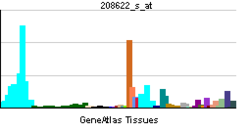- Ezrin
-
Ezrin also known as cytovillin or villin-2 is a protein that in humans is encoded by the EZR gene.[1]
The cytoplasmic peripheral membrane protein encoded by this gene functions as a protein-tyrosine kinase substrate in microvilli. As a member of the ERM protein family, this protein serves as an intermediate between the plasma membrane and the actin cytoskeleton. It plays a key role in cell surface structure adhesion, migration, and organization.[2]
Interactions
VIL2 has been shown to interact with Sodium-hydrogen exchange regulatory cofactor 2,[3][4] Merlin,[5] SDC2,[6] CD43,[7] Fas ligand,[8][9] VCAM-1,[10] S100P,[11] ICAM3,[12][13] ICAM-1,[12] Sodium-hydrogen antiporter 3 regulator 1,[14][15] ICAM2,[12] Moesin,[8][16][17] PALLD[18] and PIK3R1.[19]
References
- ^ Gould KL, Bretscher A, Esch FS, Hunter T (December 1989). "cDNA cloning and sequencing of the protein-tyrosine kinase substrate, ezrin, reveals homology to band 4.1". EMBO J. 8 (13): 4133–42. PMC 401598. PMID 2591371. http://www.pubmedcentral.nih.gov/articlerender.fcgi?tool=pmcentrez&artid=401598.
- ^ "Entrez Gene: VIL2 villin 2 (ezrin)". http://www.ncbi.nlm.nih.gov/sites/entrez?Db=gene&Cmd=ShowDetailView&TermToSearch=7430.
- ^ Yun, C H; Lamprecht G, Forster D V, Sidor A (Oct. 1998). "NHE3 kinase A regulatory protein E3KARP binds the epithelial brush border Na+/H+ exchanger NHE3 and the cytoskeletal protein ezrin". J. Biol. Chem. (UNITED STATES) 273 (40): 25856–63. doi:10.1074/jbc.273.40.25856. ISSN 0021-9258. PMID 9748260.
- ^ Sitaraman, Shanthi V; Wang Lixin, Wong Michelle, Bruewer Matthias, Hobert Michael, Yun C-H, Merlin Didier, Madara James L (Sep. 2002). "The adenosine 2b receptor is recruited to the plasma membrane and associates with E3KARP and Ezrin upon agonist stimulation". J. Biol. Chem. (United States) 277 (36): 33188–95. doi:10.1074/jbc.M202522200. ISSN 0021-9258. PMID 12080047.
- ^ Grönholm, M; Sainio M, Zhao F, Heiska L, Vaheri A, Carpén O (Mar. 1999). "Homotypic and heterotypic interaction of the neurofibromatosis 2 tumor suppressor protein merlin and the ERM protein ezrin". J. Cell. Sci. (ENGLAND) 112 ( Pt 6): 895–904. ISSN 0021-9533. PMID 10036239.
- ^ Granés, F; Urena J M, Rocamora N, Vilaró S (Apr. 2000). "Ezrin links syndecan-2 to the cytoskeleton". J. Cell. Sci. (ENGLAND) 113 ( Pt 7): 1267–76. ISSN 0021-9533. PMID 10704377.
- ^ Serrador, J M; Nieto M, Alonso-Lebrero J L, del Pozo M A, Calvo J, Furthmayr H, Schwartz-Albiez R, Lozano F, González-Amaro R, Sánchez-Mateos P, Sánchez-Madrid F (Jun. 1998). "CD43 interacts with moesin and ezrin and regulates its redistribution to the uropods of T lymphocytes at the cell-cell contacts". Blood (UNITED STATES) 91 (12): 4632–44. ISSN 0006-4971. PMID 9616160.
- ^ a b Gajate, Consuelo; Mollinedo Faustino (Mar. 2005). "Cytoskeleton-mediated death receptor and ligand concentration in lipid rafts forms apoptosis-promoting clusters in cancer chemotherapy". J. Biol. Chem. (United States) 280 (12): 11641–7. doi:10.1074/jbc.M411781200. ISSN 0021-9258. PMID 15659383.
- ^ Parlato, S; Giammarioli A M, Logozzi M, Lozupone F, Matarrese P, Luciani F, Falchi M, Malorni W, Fais S (Oct. 2000). "CD95 (APO-1/Fas) linkage to the actin cytoskeleton through ezrin in human T lymphocytes: a novel regulatory mechanism of the CD95 apoptotic pathway". EMBO J. (ENGLAND) 19 (19): 5123–34. doi:10.1093/emboj/19.19.5123. ISSN 0261-4189. PMC 302100. PMID 11013215. http://www.pubmedcentral.nih.gov/articlerender.fcgi?tool=pmcentrez&artid=302100.
- ^ Barreiro, Olga; Yanez-Mo Maria, Serrador Juan M, Montoya Maria C, Vicente-Manzanares Miguel, Tejedor Reyes, Furthmayr Heinz, Sanchez-Madrid Francisco (Jun. 2002). "Dynamic interaction of VCAM-1 and ICAM-1 with moesin and ezrin in a novel endothelial docking structure for adherent leukocytes". J. Cell Biol. (United States) 157 (7): 1233–45. doi:10.1083/jcb.200112126. ISSN 0021-9525. PMC 2173557. PMID 12082081. http://www.pubmedcentral.nih.gov/articlerender.fcgi?tool=pmcentrez&artid=2173557.
- ^ Koltzscher, Max; Neumann Claudia, König Simone, Gerke Volker (Jun. 2003). "Ca2+-dependent binding and activation of dormant ezrin by dimeric S100P". Mol. Biol. Cell (United States) 14 (6): 2372–84. doi:10.1091/mbc.E02-09-0553. ISSN 1059-1524. PMC 194886. PMID 12808036. http://www.pubmedcentral.nih.gov/articlerender.fcgi?tool=pmcentrez&artid=194886.
- ^ a b c Heiska, L; Alfthan K, Grönholm M, Vilja P, Vaheri A, Carpén O (Aug. 1998). "Association of ezrin with intercellular adhesion molecule-1 and -2 (ICAM-1 and ICAM-2). Regulation by phosphatidylinositol 4, 5-bisphosphate". J. Biol. Chem. (UNITED STATES) 273 (34): 21893–900. doi:10.1074/jbc.273.34.21893. ISSN 0021-9258. PMID 9705328.
- ^ Serrador, Juan M; Vicente-Manzanares Miguel, Calvo Javier, Barreiro Olga, Montoya Maria C, Schwartz-Albiez Reinhard, Furthmayr Heinz, Lozano Francisco, Sánchez-Madrid Francisco (Mar. 2002). "A novel serine-rich motif in the intercellular adhesion molecule 3 is critical for its ezrin/radixin/moesin-directed subcellular targeting". J. Biol. Chem. (United States) 277 (12): 10400–9. doi:10.1074/jbc.M110694200. ISSN 0021-9258. PMID 11784723.
- ^ Brdicková, N; Brdicka T, Andera L, Spicka J, Angelisová P, Milgram S L, Horejsí V (Oct. 2001). "Interaction between two adapter proteins, PAG and EBP50: a possible link between membrane rafts and actin cytoskeleton". FEBS Lett. (Netherlands) 507 (2): 133–6. doi:10.1016/S0014-5793(01)02955-6. ISSN 0014-5793. PMID 11684085.
- ^ Reczek, D; Berryman M, Bretscher A (Oct. 1997). "Identification of EBP50: A PDZ-containing phosphoprotein that associates with members of the ezrin-radixin-moesin family". J. Cell Biol. (UNITED STATES) 139 (1): 169–79. doi:10.1083/jcb.139.1.169. ISSN 0021-9525. PMC 2139813. PMID 9314537. http://www.pubmedcentral.nih.gov/articlerender.fcgi?tool=pmcentrez&artid=2139813.
- ^ Gary, R; Bretscher A (Aug. 1995). "Ezrin self-association involves binding of an N-terminal domain to a normally masked C-terminal domain that includes the F-actin binding site". Mol. Biol. Cell (UNITED STATES) 6 (8): 1061–75. ISSN 1059-1524. PMC 301263. PMID 7579708. http://www.pubmedcentral.nih.gov/articlerender.fcgi?tool=pmcentrez&artid=301263.
- ^ Gary, R; Bretscher A (Nov. 1993). "Heterotypic and homotypic associations between ezrin and moesin, two putative membrane-cytoskeletal linking proteins". Proc. Natl. Acad. Sci. U.S.A. (UNITED STATES) 90 (22): 10846–50. doi:10.1073/pnas.90.22.10846. ISSN 0027-8424. PMC 47875. PMID 8248180. http://www.pubmedcentral.nih.gov/articlerender.fcgi?tool=pmcentrez&artid=47875.
- ^ Mykkänen, O M; Grönholm M, Rönty M, Lalowski M, Salmikangas P, Suila H, Carpén O (Oct. 2001). "Characterization of human palladin, a microfilament-associated protein". Mol. Biol. Cell (United States) 12 (10): 3060–73. ISSN 1059-1524. PMC 60155. PMID 11598191. http://www.pubmedcentral.nih.gov/articlerender.fcgi?tool=pmcentrez&artid=60155.
- ^ Gautreau, A; Poullet P, Louvard D, Arpin M (Jun. 1999). "Ezrin, a plasma membrane-microfilament linker, signals cell survival through the phosphatidylinositol 3-kinase/Akt pathway". Proc. Natl. Acad. Sci. U.S.A. (UNITED STATES) 96 (13): 7300–5. doi:10.1073/pnas.96.13.7300. ISSN 0027-8424. PMC 22080. PMID 10377409. http://www.pubmedcentral.nih.gov/articlerender.fcgi?tool=pmcentrez&artid=22080.
Further reading
- Martin TA, Harrison G, Mansel RE, Jiang WG (2004). "The role of the CD44/ezrin complex in cancer metastasis.". Crit. Rev. Oncol. Hematol. 46 (2): 165–86. doi:10.1016/S1040-8428(02)00172-5. PMID 12711360.
PDB gallery Categories:- Human proteins
- Chromosome 6 gene stubs
Wikimedia Foundation. 2010.





